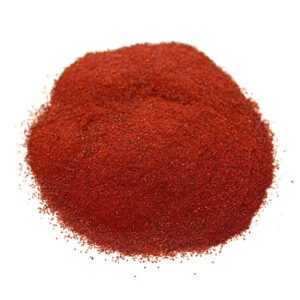Description
Colour Index Number: CI 75120
CAS number: 1393-63-1 / 542-40-5
EC number.215-735-4 / 208-810-8
Annatto is an orange-red condiment and food coloring derived from the seeds of the achiote tree (Bixa orellana) native to tropical regions from Mexico to Brazil. It is often used to impart a yellow or orange color to foods, but sometimes also for its flavor and aroma. Its scent is described as “slightly peppery with a hint of nutmeg” and flavor as “slightly nutty, sweet and peppery”.
The color of annatto comes from various carotenoid pigments, mainly bixin and norbixin, found in the reddish waxy coating of the seeds. The condiment is typically prepared by grinding the seeds to a powder or paste. Similar effects can be obtained by extracting some of the color and flavor principles from the seeds with hot water, oil, or lard, which are then added to the food.
Annatto and its extracts are now widely used in an artisanal or industrial scale as a coloring agent in many processed food products, such as cheeses, dairy spreads, butter and margarine, custards, cakes and other baked goods, potatoes, snack foods, breakfast cereals, smoked fish, sausages, and more. In these uses, annatto is a natural alternative to synthetic food coloring compounds, but it has been linked to rare cases of food-related allergies. Annatto is of particular commercial value in the United States because the Food and Drug Administration considers colorants derived from it to be “exempt of certification”.
source:https://en.wikipedia.org/wiki/Annatto
What is the difference between a dye and a pigment?
Pigments
There are two different types of pigments: Natural and Synthetic. Pigments are insoluble materials that are ground into a fine powder so that they can be suspended in a binder (usually an oil). Insolubility means that pigments can never be dissolved into the binder, the fine particles of the powder are suspended and stay solid in the binder. The binder surrounds the pigment particles and holds them in place.
Pigments produce paints that are more opaque than dyes and have low tinting strength. Opacity is the ability for paint to cover and hide another dried color that it has been applied over. Tinting strength is how well a color mixes with other colors. (Example: When mixing blue with white, how well does the blue disperse into the white? or How blue does the white look after the mixing?)
The first colorants that were used to create paint were naturally occuring earthen pigments. Prehistoric people used ochres and iron oxides to create images on cave walls in Lascaux, France. Many natural insoluble pigments are still used today in artists’ paints. Metals are also natural insoluble pigments, like cadmium, titanium, and lead (very toxic).
Dyes
There two types of dyes: Natural and Synthetic. Dyes, in contrast to pigments, are soluble colorants. Solubility means that dyes are dissolved into a binder (usually water). Dyes are more transparent than pigments. Transparency of dyes makes these colors very good for glazing over previous layers of paint. Dyes have high tinting strength. A dye based paint, like pthalo blue, concentrates its own color when mixed with another color of paint, like titanium white.
Dyes originally were derived from natural sources. Plants were primarily used to get dyes. Today some dyes are still organic, but many are created from synthetic materials. Indian Yellow is a good example of why synthetic dyes have replaced some naturally derived colors. The original Indian Yellow was made from dried elephant urine, but now it is considered inhumane to force an healthy diet onto an animal in order to influence the color of their urine. Today’s Indian Yellow is made from a synthetic dye.
Please note that if you purchase a dye, it may come in either granular or powder form, depending on availability. We provide the granular for wherever possible, as it is easier to handle and produces less airborne dust.

